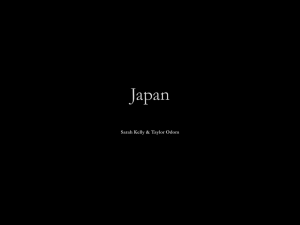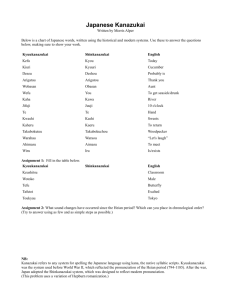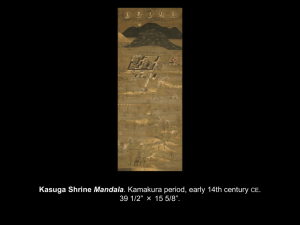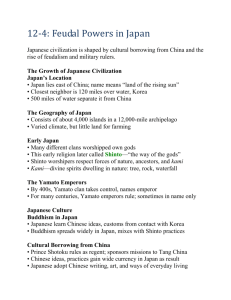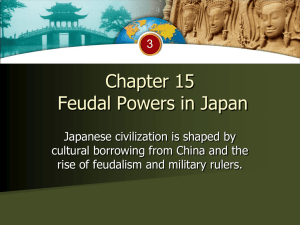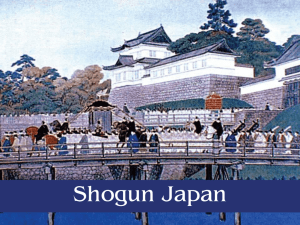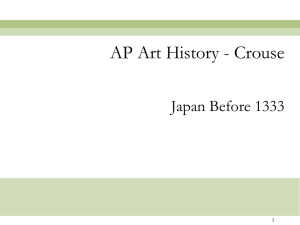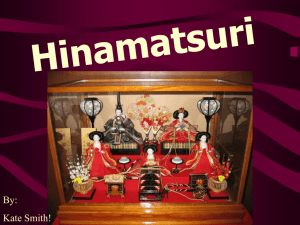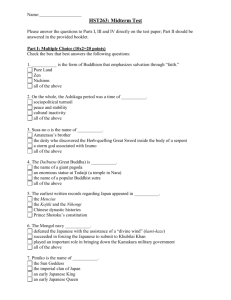Japan - Art History
advertisement
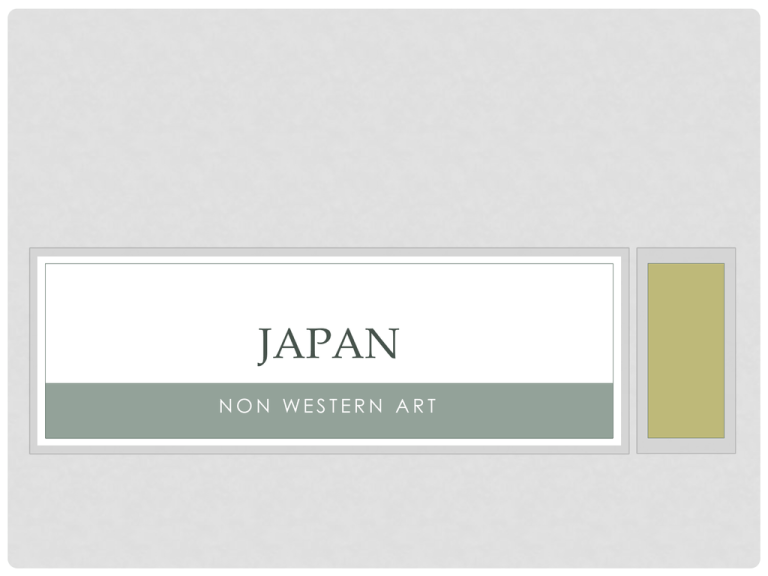
JAPAN NON WESTERN ART JAPAN • Japanese culture is the product of long periods of isolation followed by eras of contact with outside cultural influences • Japanese art was influenced by China and Korea from the 7th-9th centuries • China and Europe in the 16th century • Final opening of Japan to the west following 1868 • Inherent characteristics: simplicity of design and form, attentiveness to beauty and nature and subtlety • Infusions of outside cultural ideas usually stimulated development of the arts emphasizing ornamentation and elaborate refinement • In reaction, these phases were followed by periods of basic simplicity and renewed attentiveness to natural design JAPAN Pomegran ates Katsushika Hokusai 1760-1849 Ink and color on paper Japan What do you think of the saying “less is more” in respect to Japanese art such as this? JAPAN Great Buddha Hall Todai-ji Nara, Japan Japanese tend to seek blending their architecture with natural environment surrounding it JAPAN JAPAN • Sometimes referred to as the “land of the rising sun”, Japan consists of four main islands and 4000 smaller islands • 2/3 of the land is mountainous and thickly forested • Majority of Japanese live very closely packed together in coastal regions • Japan’s isolation from Asian mainland contributed to development of a distinct culture JAPAN JAPAN • A typical Japanese hallmark in homes is painted screens • Japanese infuse arts into all aspects of daily life • Household screens and slide doors are often eloquently painted with scenes from nature JAPAN Hasegawa Tohaku Pine Wood 1539-1610 (detail from a pair of silk-fold screens) Tokyo National Museum Gilt screening in the interior of the Nijo Palace- daimyo palace (feudal lord/ landowner) Messenger room Rectangular pattern of traditional architecture JAPAN TIMELINE • • • • • • • • • • • • • C. 9000-200 BC Jomon Phase 200 BC-300 AD Yayoi Period 552 AD- 645 AD Asuka Period 645 AD- 794 AD Nara Period 794 AD- 1185 AD Heian Period 1185 AD– 1392 AD Kamakura Period 1334 AD-1573 AD Muromachi Period 1573 AD- 1615 AD Momoyama Period 1615-1868 AD Edo Period 1868 AD- 1912 AD Meiji Period 1912 AD- 1926 AD Taisho Period 1926 AD- 1989 AD Showa Period 1989 AD- present Heisei Period JOMON CULTURE • Little is known about Japan’s early history • Origins may date back as far as 5000 BD during Neolithic Jomon culture • Produced simple undecorated food vessels made of red clay • By 2000 BD, colored slip was used to create animal and human abstract patterns JOMON CULTURE Bottle, Late Jomon period (ca. 1500– 1000 B.C.) Japan Earthenware with incised designs Typical of wares found in Japan for this time period Simplistic design, red clay pottery Two sets of apertures, thread cord and suspend 7 ½ inches, 19 cm JOMON CULTURE Spearhead, Late Jomon period (ca. 1500–1000 B.C.) Japan Stone; L. 3 1/8 in. (7.9 cm) Carefully formed shape Beveled edge JOMON CULTURE Storage jar, Middle Jomon period (ca. 2500–1500 B.C.) Japan Earthenware, unglazed; H. 27 1/2 in. (69.9 cm) • • • • • Cord-marked pottery - characteristic ware of the earliest inhabitants of Japan People were fishers and hunters on islands handmade utilitarian wares were treated with inventive, often extravagant artistry regional separations between groups resulted in wide range of styles. The cord-marked pattern was made by cords being twisted together over and over on the piece- herringbone pattern YAYOI PERIOD • Fourth century- Jomon culture superceded by Yayoi • More advanced • More agrarian people- influenced from mainland Asia • Flourishes until 3rd century • Yayoi people mainly farmers • Art as utility • Thatched huts clustered into villages • Social classes begin to emerge, increasing wealth • Mainland introduces production of iron and bronze making sculpture possible YAYOI PERIOD Bust of a female figurine, Final Jomon period/ Yayoi Period (ca. 1000– 300 B.C.) Japan Earthenware with incised and cord– marked designs Dogu- stylized, hollow figurine True meaning of eyes unknown- Inuit of NA Crown atop figure’s head Her body deco’d deeply incised lines and cordmarkings possibly suggesting tattoos Other dogus possibly used as fertility symbols YAYOI PERIOD Needles, hooks, and harpoon, Final Jomon period (ca. 1000–300 B.C.) Japan Bone Notice craftsmanship Compare to arrowhead YAYOI PERIOD Small figurine, Final Jomon period (ca. 1000–300 B.C.) Japan Earthenware; H. 2 1/2 in. (5.7 cm) Small figurines (dogu) super popular Highly stylized Body as fertility symbols Found broken often, and intentionally? Why? Cures- scattered in trash rather than graves YAYOI PERIOD Storage jar, Yayoi period (ca. 4th century B.C.–3rd century A.D.) Japan Earthenware; H. 10 in. (25.4 cm) Irregularities and ornamentation replaced with sturdy, functional pieces Symmetry paramount ASUKA PERIOD • Asuka became Japanese capital from 538-645 • Gave name to time when Buddhist missionaries, scriptures and beliefs were welcomed • Confucian ideals of government put into place • Older Japanese religion- Shinto- continued to influence Japanese thought • Shinto- “the way of the gods” • Oldest and still largest religion in Japan • Began as a form of nature worship, gods dwell throughout the world of nature • Later included worship of ancestors ASUKA PERIOD • Lots of ideas from China • More sophisticated culture adopted due to influence of literature, philosophy, art, architecture, science, medicine and government • Revolutionized Japan, giving them writing system as well ASUKA PERIOD Large jar, late Kofun or Asuka period (ca. 3rd century–710), 6th–7th century Japan Stoneware with natural ash glaze and comb and cord markings -notice similar markings to earlier art ASUKA PERIOD Kanzeon Bosatsu, wood sculpture with gold leaf 7th century Asuka period ASUKA PERIOD • Tang Chinese architecture was emulated in building the first Buddhist structures- the Horyu-ji temple at Asuka • Main hall and adjacent pagoda still exist as the oldest wooden structures in the world • Buildings are regarded as faithful reproduction of Chinese architecture from the Tang Dynasty • Style reflects calm and graceful atmosphere as well as structural honesty in exposure of the beams and brackets ASUKA PERIOD Horyu-ji Temple Complex Begun 607 Asuka, Japan ASUKA PERIOD Exposure of beams and brackets NARA PERIOD • Capital moved to nearby Nara, new era began • Furniture, paintings, pottery and architecture were all based on Chinese ideals • Court sponsored elaborate production and collection of art, incl works from China and Persia • Buddhism firmly entrenched • Huge temples and monasteries constructed in wood of Chinese style • Buddhist images were made of lacquer and bronze NARA PERIOD Great Dibutsu (Buddha) Bronze Todai-ji temple Nara Japan Largest Buddha sculpture in Japan, 70 ft high, 700 ton Buddha housed in largest wooden temple in the world NARA PERIOD Miniature pagoda, early Nara period (710–794; ca. 767) Japan Wood; H. 8 1/4 in NARA PERIOD Long–necked bottle, Nara period (710–794), 8th century Japan Stoneware with natural ash glaze and incised decoration Glazes- Chinese influence NARA PERIOD • Inspired by Chinese precedent, Japan’s first histories were written- Kojiki and Nihon shoki • Chinese precedent seen in decision to adopt Buddhism as official religion • Large temples constructed, many hours and money put into it • However, not even a full century after it was built, capital was moved again • Burdensome pressure of Buddhist temples, grew too wealthy and powerful • Excessive influence of Buddhist establishment, heavy taxes on rice, products and labor and increase in challenges to government led to unrest NARA PERIOD Todai-ji Temple Nara, Japan HEIAN PERIOD Heian, today Kyoto, became capital in 784 Golden age of Japanese art Heian- literally meaning period of calm and tranquility Close ties with China broken, Japanese artists created own styles of art that differed from Chinese • Yamato-e painting evolved during this perioddecorative scrolls with long narratives expressing Japanese taste, sentiments and nationalistic feelings (literally meaning Japanese painting, differing from karae painting meaning Tang painting) • Yamato-e painting- native subject matter from Japanese literature • • • • HEIAN PERIOD • Most paintings from this period were done on folding screens or sliding door panels, so not much is left of them • Recollections of them due to Japanese waka poetry- 31 syllable poems created in conjunction with yamato-e paintings, or inspired by them • In ancient legends, reference is made to a portrait of the Buddha Gautama that was made of sandalwood and left unpainted • Wooden sculptures of Buddha were often carved from a fragrant piece of wood, sandalwood or cypress and left unpainted. • Why? Advantages? For whom? HEIAN PERIOD Fudō Myōō (Achala– vidyārāja), Heian period (794–1185, 12th century Japan Fierce protector- how can you tell? HEIAN PERIOD The Tale of Gengi, detail Late Heian Period 12th century Scroll, color on paper HEIAN PERIOD Lotus Sutra, Heian period (794– 1185), 12th century Japan Gold on indigo– dyed paper; 11 3/4 x 339 3/4 in. (29.8 x 863 cm) KAMAKURA PERIOD • Military government replaced the Heian govt • Capital moved to Kamakura • Many early Nara temples were restored after civil wars • Huge bronze Buddha was cast • Fashion and taste were at odds with cultural heritage of Kyoto • Kamakura art more realistic KAMAKURA PERIOD Great Buddha of Kamakura Kamakura period Japan Cast bronze tour KAMAKURA PERIOD • During this period, Zen Buddhism from China gained popularity • Promoted spiritual exercises, meditation and simple lifestyle • Paintings stressed portraiture, battle scenes and incidents taken from real life (called….. ?) • Also could depict torments in hell, illness and suffering. The irony, huh • Potters who studied Song ceramic methods established kilns leading to native Japanese ceramic tradition • Objects produced there became important for cha-no-yu- Zen inspired tea ceremony KAMAKURA PERIOD Illustrated Legends of the Kitano Shrine (Kitano Tenjin Engi), Kamakura period (1185–1333), 13th century Unidentified artist Japan Handscroll; ink and color on paper KAMAKURA PERIOD Armor (yoroi), Late Kamakura period (1185–1333), early 14th century Japanese Lacquered iron and leather, silk, stenciled leather, copper-gilt KAMAKURA PERIOD A Long Tale for an Autumn Night (Aki no yonaga monogatari), Nanbokucho period (1336–92), late 14th century Japan Scroll one from a set of three handscrolls; ink, color, and gold on paper; KAMAKURA PERIOD Illustrated sutra of The Miracles of Kannon, Kamakura period (1185–1333), dated 1257 Unidentified artist Japan Handscroll; ink, color, and gold on paper; 9 7/16 in. x 30 ft. 8 1/16 in MUROMACHI AND MOMOYAMA PERIODS • Kyoto reestablished as capital in 1338, initiating Muromachi era • Warrior class patronized the arts • Ostentatious court life • Contrasting their incessant warfare, tranquil landscapes gardens provided respite and a place to chill • Natural architecture and peaceful arrangements • Spiritual peace also available in Noh- dramas, cha-no-yu – tea ceremonies, and ikebana- flower arranging • Tokonoma- special alcove for art • First steps in establishment of modern commercial, transportation and urban developments MUROMACHI AND MOMOYAMA PERIODS Possible cha-no-yu spot Notice the tokonama? The tea set? The flower arrangement? MUROMACHI AND MOMOYAMA PERIODS • Muromachi painting dominated by Chinese ink style, sumi-e • Usually done on absorbant rice paper (washi) in quick confident strokes, style was also used on sliding door panels and screens by a family of painters named Kano • Their style of painting influenced the Momoyama era • Used during that era to embellish rooms in large castles built by feudal war lords- daimyo • Paintings of tress and nature scenes MUROMACHI AND MOMOYAMA PERIODS Portrait sculpture of a Zen priest, Muromachi period (1392–1573), 14th– 15th century Japan Lacquered wood MUROMACHI AND MOMOYAMA PERIODS Helmet (Suji Kabuto), Muromachi period, 15th century Japan Lacquered iron, silk, stenciled leather, gilt copper Inscribed on the helmet MUROMACHI AND MOMOYAMA PERIODS Birds and Flowers of the Four Seasons, Momoyama period (1573–1615), early 17th century Kano School Japan Pair of six–fold screens; color on gold–leafed paper MUROMACHI AND MOMOYAMA PERIODS Su Dongpo in Straw Hat and Wooden Shoes, Muromachi period (1392–1573), second half of 15th century Artist Unknown Japan Hanging scroll; ink on paper EDO PERIOD • Internal political turmoil caused Japanese rulers to attempt to impose order by closing Japan off from outside world • European and Christian influences were banned in 1612 • Capital moved to Edo • Meiji Restoration- restored practical imperial rule-Japan opened again to influences • Unique style of genre painting- ukiyo-e • Ukiyo-e- unique creation of Edo period- art of the floating world • Very popular with growing middle class • Featured colorful images of daily life, later adapted to woodcuts and marketed at super low prices EDO PERIOD Night Rain at Karasaki, from the series Eight Views of Ō-mi Artist: Utagawa Hiroshige Period: Edo period (1615– 1868) Date: ca. 1835 Culture: Japan Medium: Polychr ome woodblock print; ink and color on paper EDO PERIOD • Ukiyo-e paintings provided glimpses of Japanese life • Bold design • Impressionist painters were especially influenced by this style- Monet, Renoir, Degas • Daimyo and their samurai retainers and other wealthy citizens were very supportive of the arts during this time • Entusiastically patronized various pleasure quarters established in all large cities • Pursuit of pleasure bc they had money, but no social status • Hedonistic world- courtesans, entertainers, teahouses, theaters, restaurants…..etc EDO PERIOD The Great Wave at Kanagawa (from a Series of Thirty-Six Views of Mount Fuji), Edo period (1615–1868), ca. 1831–33 Katsushika Hokusai (Japanese, 1760– 1849 Polychrome ink and color on paper EDO PERIOD MODERN PERIOD • Non- Japanese painting techniques, notably oil painting, were introduced by Catholic missionary priests • Later encouraged under Meiji Era • Ming and Qing ceramics influenced Japanese pottery production • Imari and Kutani porcelain wares are brightly surfaced and boldly colored MODERN PERIOD Imari and Kutani porcelain QUESTIONS • • • • • • • • • • • • • What are some of the beliefs of the Shinto religion? What are the oldest wood structures in the world? How old are they? Where is the great Dibutsu? Which is taller, Seay’s art classroom of the statue? What modern cities did the ancient cities of Heian and Edo become? What is yamato-e painting? On what type of surface were these painted? How as Kamakura art different from Heian art? What were some of the subjects of Kamakura art? What is the Japanese term for the zen-inspired tea ceremony> which Chinese dynasty art influenced the production of these pieces? What do noh, ikebana and tokonoma mean? What does sumi-e mean? What does washi mean? What does ukiyo-e mean?
